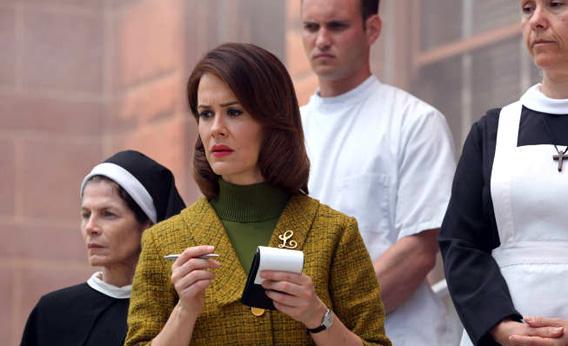You remember Shutter Island? Martin Scorsese’s adaptation of the Dennis Lehane novel? An A-list B-movie homage about a war veteran sealed inside a Massachusetts nuthouse? You remember every hallway clattering like Samuel Fuller’s Shock Corridor? Operatic visions of expressionistic gore? A hospital ethics committee certified by Josef Mengele? Well, the subtitular institution on American Horror Story: Asylum (FX, Wednesdays at 10 p.m. ET) makes that place look like the Mayo Clinic. Creators Ryan Murphy and Brad Falchuk vibrate on much the same frequency—and they ratchet up Scorsese’s Catholic-school Gothicism, and they Ratched up the scenario, and they apply a no-shame high gloss to deliver wet kisses to cinematic trash.
The first season of AHS centered on a troubled Boston family that moved to contemporary Los Angeles for a fresh start—only to discover that they were living next door to the splatter-film version of a wacky neighbor, played by Jessica Lange. This second season tosses out the setting and characters of the first while recasting some actors and retaining most themes. Returning performers include Zachary Quinto, Sarah Paulson, and the Emmy-winning Lange, who this time plays the sadist-in-chief at Massachusetts’ Briarcliff Hospital—Sister Jude, a nun with many a nasty habit. Recurring themes include genre-flick pastiche, kinky provocation, and an understanding of the nature of evil seemingly inspired by a bad drug experience during an Omen sequel.
And as before—and for no discernible reason beyond branding the show with a distinctive time-warp signature—Asylum rolls down two timelines at once. The first time around, the vignettes of vintage slaughter scenes were different each week and sometimes involved the principal characters; the repressed returned, and the past collapsed on the present. This time around, when the action starts, it’s the present day, and two attractive young people, one played by the guy from Maroon 5, are thrumming ecstatically through the very earliest days of their marriage. They’re touring “the 12 most-haunted places in America” because she identifies herself, lubriciously, as a “horror freak.” Honeymooners do adore doing their marital duty on unconventional surfaces—white-sand beaches, for instance, and blackjack tables. But an electroconvulsive-therapy chair? That vacation will not end well, and two episodes in, that small corner of the story is doing little other than announcing that AHS has moved its Eros-and-Thanatos shock tactics to a new address.
But in the new season’s more propulsive storyline, the year is 1964, and forbidden love is in the air, along with who-knows-what-else because the air is thick with sulfurous atmospherics. A white guy named Kit Walker (played by Evan Peters) stands accused of killing his black wife. And a few other women too. And skinning them all, we are told, a good gratuitous touch to juice up the Ewws. Hello, and welcome to Briarcliff, Kit! The homicidal gargoyles in the recreation room are your new neighbors.
Is he the real killer? I doubt it. Asylum presents a highly abstract vision of the moment of the crime, depicting Kit thrown against the roof of his home and touched in the chest by a 5-foot-long demon’s claw. He seems like a decent fellow, and a young lady named Grace takes an interest in him, surely a sign of heaven’s favor on the hooting hellscape of this show.
He arrives to Briarcliff on the same day that a lesbian reporter named Lana Winters (Paulson) pays a visit. Her assignment is to write about Briarcliff’s famed bakery, but she’s looking for a scoop on Kit and soon grows intrigued by the workings on the institution. And why not? When she shows up, Sister Jude is administering a haircut to the resident nympho (Chloe Sevigny) in punishment for rubbing up against whatever man nearest her happened to move. It seems that Sister Jude’s typical day involves dispensing beatings to the patients, spankings to the staff, fantasizing about receiving indulgences (if you know what I mean) from her monsignor (Joseph Fiennes), and chatting with her chief physician (James Cromwell) about all those people he’s been killing.
But, really, there are no typical days at this asylum. You never know when you’re going to have to call in an exorcist or make allusions to The Exorcist or chastise the nympho for hiding a cucumber in her room or attend to any of various cast-iron pots steadily boiling with a mixture of fear and desire. We critics who admire Pauline Kael sometimes rely a bit much on the phrase fever dream. But there’s no way around applying the term to Asylum. That’s its genre. Less scary than freaky, it’s deliberately unhinged—light horror about low camp, a showcase for scenery chewing and giddy blasphemy, an exploitation chamber piece.
